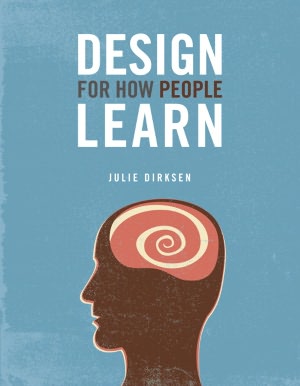- Home
- Articles
- Reviews
- About
- Who we are
- Write for us
- Contact us
About
- Archives
- Past Issues
- The eLearn Blog
Archives
| To leave a comment you must sign in. Please log in or create an ACM Account. Forgot your username or password? |
|
Create an ACM Account |

I'm always slightly amused by the number of contrasts we have in the literature of our field. Books on rapid design and development that weigh in at more than 500 pages. Books espousing the importance of engagement that read like dissertations dry ones. And then there are books that espouse bad practice, or otherwise set up the earnest reader to fail.
In contrast, one of the things I appreciate most about Design for How People Learn is that Julie Dirksen applies her own advice. First and foremost, she writes for how people like to read. The style is conversational, varied, and fun. She tells stories and makes liberal use of examples and non-examples, both hypothetical and from her experience. But it's also clear that this book wasn't just written; it was designed. There's barely a page that doesn't have a sketch, screenshot, comic, table, or photo. Those visual interludes not only reinforce the text, they allow some space for reflection and also provide easy, immediate re-entry when the reader has to leave and come back. Frankly, I didn't expect a book that's not accompanied by any actual elearning examples could do such a good job showing (rather than telling about) successful learning design, but Dirksen has found ways to get it done.
As you may have have inferred from the "How People Learn" part of the title, this book does apply research on cognition. All of the studies and writings Dirksen mentions deserve your further exploration; they're contributions to the field that learning designers should be aware of, study, and form opinions about. At the same time, though, this book doesn't blind you with science. Dirksen provides a point of entry into the world of research, but she writes for practitioners and applies both scientific findings and lessons learned from experience in real-world ways.
In particular, I was very appreciative of the time she took to debunk some of the popular but as-of-yet-unsupported-by-research standbys in our field, namely "learning styles." She replaces this lens with one that is far more helpful: that of the "learner type," any of which could be any of us, depending on the situation. These include the "Just tell me what I need to know" learner, the "I fear change" learner, the "I need to solve a problem" learner, the "Hey! This is cool!" learner and others. Practitioners who have designed a single course or trained for a single day have met these learners and know that they have very different needs. Dirksen addresses how to realistically anticipate those needs and meet them.
This book is definitely one I will suggest to beginning learning designers. I also recommend it to experienced designers, though; not only does it show some creative ways to address design challenges, the book as a whole presents one of the strongest, simplest-to-understand arguments I've seen for keeping the learners—their needs, their wants, their limits, their abilities, their preferences, their experience—at the center of our designs. User experience with technology is, by and large, improving in leaps and bounds today. I agree with Dirksen that we need to stay on par or risk becoming less valued and relevant. So even if you're an experienced designer, if the idea of learning experience design is new, this book is a great place to start.
The word "Design" in the title of this book could be read as either a noun or a command. If it's a noun, I would expect that the book would show us what this kind of design is and how to achieve it. If it's a command, I would expect the book to convince us to go forth and do it. In the end, though, I couldn't tell you which Dirksen intended. She did an outstanding job at both.
Judy Unrein (@jkunrein on Twitter) has worked in various training and instructional design roles since 1997. She now designs electronic and blending learning experiences for Artisan E-Learning and regularly shares ideas about learning and technology for conferences and publications from ASTD and the eLearning Guild, as well as eLearn Magazine, the E-Learning Uncovered blog, and her own blog at onehundredfortywords.com. She has an MBA and and M.Ed. in instructional design..
|
To leave a comment you must sign in. |
|
Create an ACM Account. |